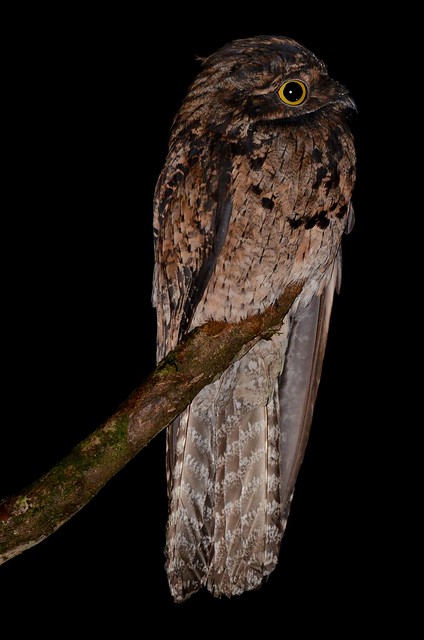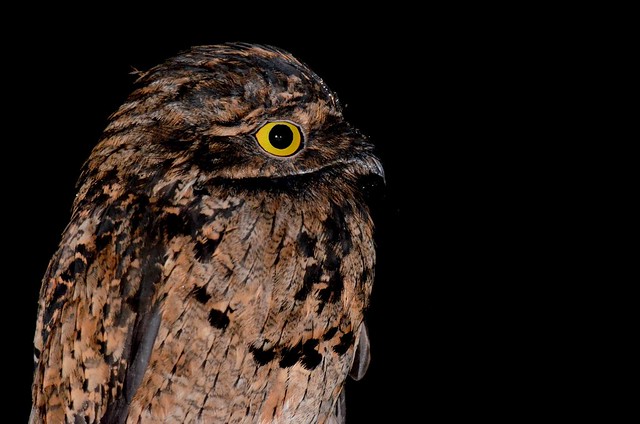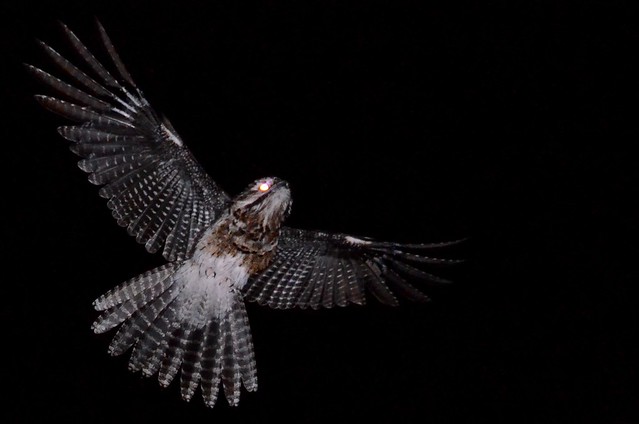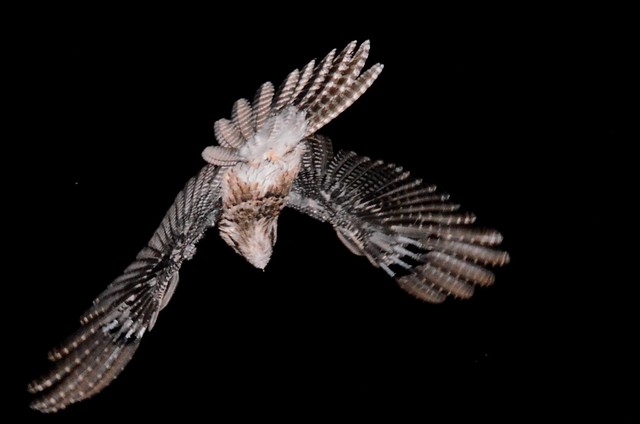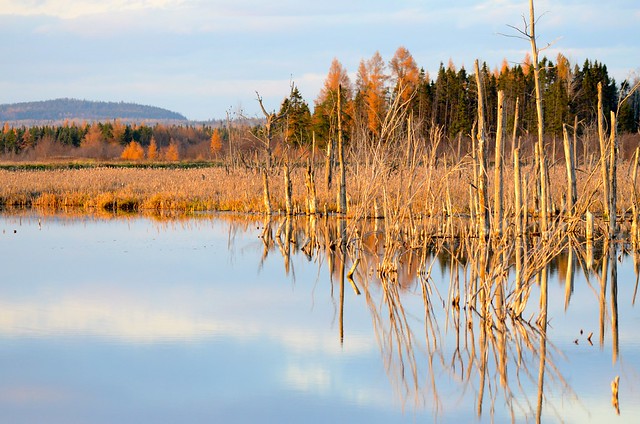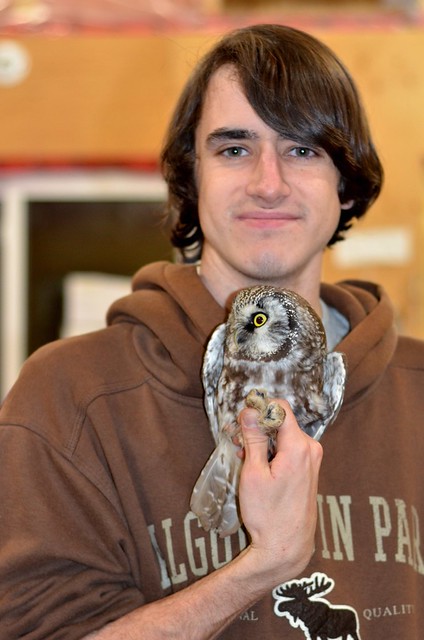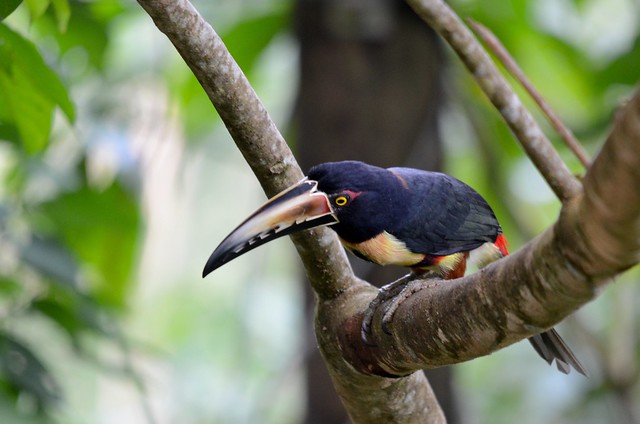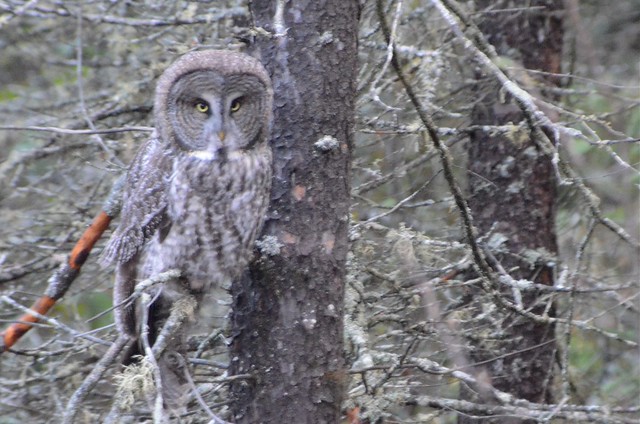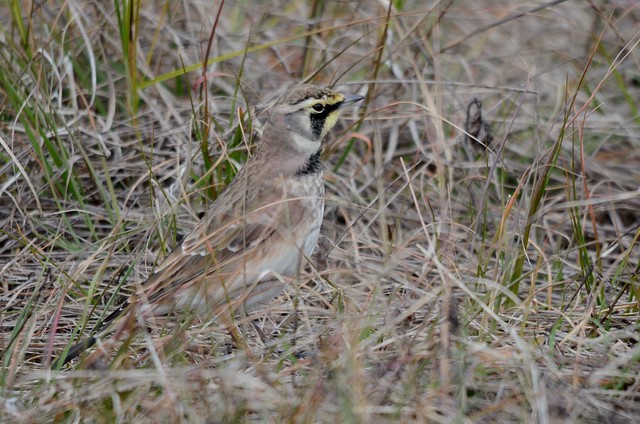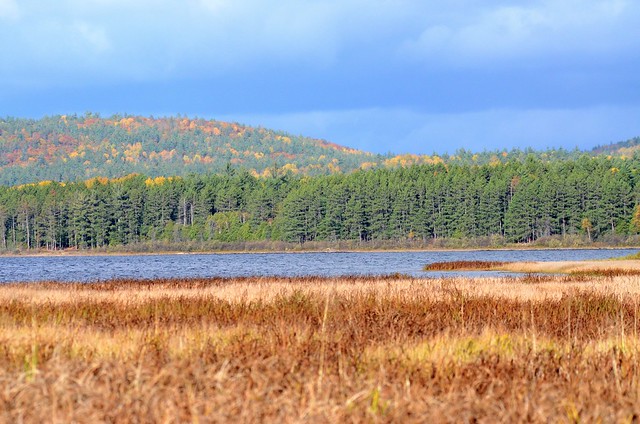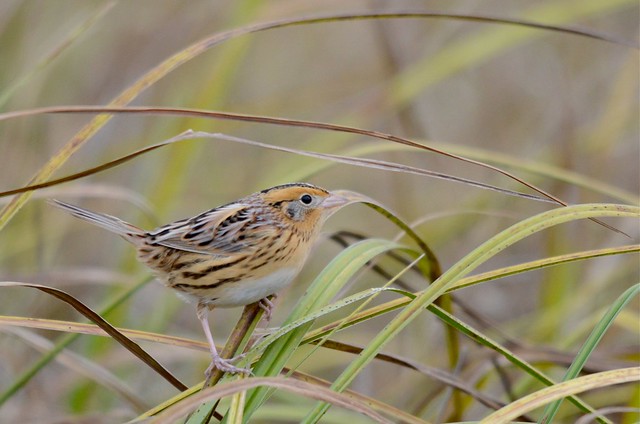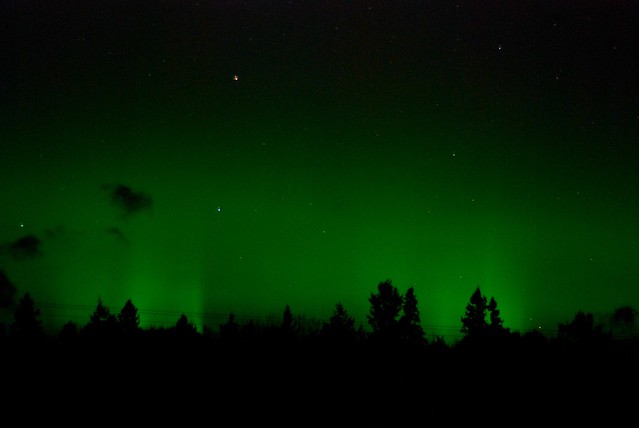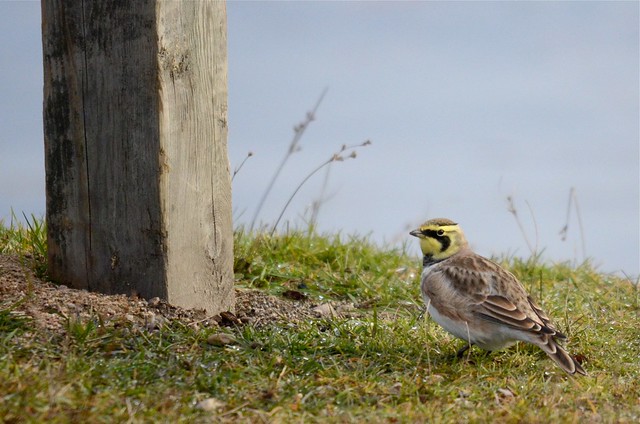There hasn't been much excitement here. It's been raining here almost constantly for about a week so getting out beyond Rancho has been difficult. The birds here have been great, but again pretty regular save for some of the migrants still coming through. We had a Gray Catbird come to the feeders briefly the other day, on it's way further south or downslope. A Black-billed Cuckoo was a highlight about two weeks ago.
On Sunday, however, I head towards the Nicaraguan border to the slopes of Volcan Tenorio to look for another cuckoo. This one is a bit tougher.
I keep a Costa Rica list and it is currently at 539. My plans for this year were to get it to 600, but we will see how that holds out because it looks to be a busy season ahead!
Already plans are in place to venture to Trinidad, Tobago, Panama and Guatemala in the first half of next year. It's shaping up to be quite a year, and we're not even there yet!
Monday, November 19, 2012
Thursday, November 1, 2012
The Potoo for You
Things are going great at Rancho and lots of work is being done getting ready for the high season, which starts next month.
One of my favourite things about Rancho is the ability to wander around the jungle at night. There are many odd things to be seen, from Tailless Whip-Scorpions to Crowned Treefrogs. There is however, one creature that I am very fond of that lives at Rancho, and to see it one must know where it sleeps during the day, or, to really see it, go out at night.
The Potoo (pronounced poe-two) is a relative of the nightjars, and like them it comes out at night to feed on large insects such as moths. By day, the bird is incredibly well camouflaged, choosing to perch on a broken-off snag to complete its disguise.
I watched another Potoo, a more active one, the other night. This bird was a hatch-year bird - aged by looking at the primaries, which were still in pin! This is how vital flight is this bird, and all the nightjars - they start to fly even before their wing is fully feathered. I was following this particular birds' fledging from when it was just a fluffball on a stick when I was still in Canada.
Then, it returned back to its original perch, like a massive nocturnal wood-pewee. I have seen the Potoo many times, but seeing one actively hunting at night was incredible.
What else was incredible, was the fact that this very bird that I dreamed of through James' and Roger's book was hunting in my front yard.
One of my favourite things about Rancho is the ability to wander around the jungle at night. There are many odd things to be seen, from Tailless Whip-Scorpions to Crowned Treefrogs. There is however, one creature that I am very fond of that lives at Rancho, and to see it one must know where it sleeps during the day, or, to really see it, go out at night.
The Potoo (pronounced poe-two) is a relative of the nightjars, and like them it comes out at night to feed on large insects such as moths. By day, the bird is incredibly well camouflaged, choosing to perch on a broken-off snag to complete its disguise.
A Common Potoo dayroosting at Rancho. Can you find it?
There are three Potoo species in Costa Rica; the Northern Potoo up in the dry forests of Guanacaste, the enormous Great Potoo down in the lowlands, and the widespread Common Potoo which is the one that we have here at Rancho.
I have seen the Potoo here many times but almost always on the dayroost, when the bird looks like a shapeless mass of feathers atop a snag. Many of us have seen owls on the dayroost and those who've seen the same birds active at night know that they look and behave completely different - as do people. You wouldn't get an accurate idea of how somebody looks if you just see them asleep (which would be somewhat strange, anyhow...)
I wanted to get to know the real Potoo so I went out on a full moon night, when the bird is active all night long (rather than on half or new moons, when they're only foraging actively for a couple of hours before dawn and after dusk) and tried to find one.
The Potoo transforms from the shapeless mass it was during the day to a huge-eyed, long-tailed ambush predator.
The beak is small, but the net-like gape is enormous and the bird is capable of swallowing enormous moths, such as Rothschildia, which form the mainstay of its diet. Rictal bristles, the hair-like feathers at the base of the mouth, help direct their prey where it should go.
Potoo's song is something to behold. The male, during full moons, emit the most eerie, thrush-like series of descending whistles that undoubtedly scared the living daylights out of early explorers and still scare unknowing nighttime jungle visitors today.
I sat there and watched the bird, fondly remembering the first time I'd read about them in Wild America, when James Fisher and Roger Peterson briefly went to Mexico with Bob Newman and collected a bird hunting moths alongside a road.
"A tree with eyes. Suddenly the dead tree's head detached itself and the eyes disappeared in a silent flutter of wings and tail...One shot was all that was necessary; the big bird dropped to the foot of the tree without a sound. We were able to examine it in the flesh, its great eyes, now dim, and its immense veined pink throat, cavernous enough to swallow small birds."
I at this point in time imagined it being an almost mythical fantasy bird, in the deep, dark jungles where few have ever explored and I thought I would never lay eyes on one. Collecting was always one of those activities that I associated with exploration and adventure, and I'd always wanted to be that explorer. This experience brought me back to that moment.
I aimed straight at the stolid Potoo on the branch. Save for looking around occasionally, the bird remained still. One shot was all that was necessary.
The beak is small, but the net-like gape is enormous and the bird is capable of swallowing enormous moths, such as Rothschildia, which form the mainstay of its diet. Rictal bristles, the hair-like feathers at the base of the mouth, help direct their prey where it should go.
Potoo's song is something to behold. The male, during full moons, emit the most eerie, thrush-like series of descending whistles that undoubtedly scared the living daylights out of early explorers and still scare unknowing nighttime jungle visitors today.
I sat there and watched the bird, fondly remembering the first time I'd read about them in Wild America, when James Fisher and Roger Peterson briefly went to Mexico with Bob Newman and collected a bird hunting moths alongside a road.
"A tree with eyes. Suddenly the dead tree's head detached itself and the eyes disappeared in a silent flutter of wings and tail...One shot was all that was necessary; the big bird dropped to the foot of the tree without a sound. We were able to examine it in the flesh, its great eyes, now dim, and its immense veined pink throat, cavernous enough to swallow small birds."
I at this point in time imagined it being an almost mythical fantasy bird, in the deep, dark jungles where few have ever explored and I thought I would never lay eyes on one. Collecting was always one of those activities that I associated with exploration and adventure, and I'd always wanted to be that explorer. This experience brought me back to that moment.
I aimed straight at the stolid Potoo on the branch. Save for looking around occasionally, the bird remained still. One shot was all that was necessary.
Now all of you readers can see those same huge eyes, vivid yellow and full of life.
I watched another Potoo, a more active one, the other night. This bird was a hatch-year bird - aged by looking at the primaries, which were still in pin! This is how vital flight is this bird, and all the nightjars - they start to fly even before their wing is fully feathered. I was following this particular birds' fledging from when it was just a fluffball on a stick when I was still in Canada.
And when they do fly, they are long-winged torpedos, far from the shapeless dayroosting birds.
It grabbed a moth in mid-air and turned around.
Then, it returned back to its original perch, like a massive nocturnal wood-pewee. I have seen the Potoo many times, but seeing one actively hunting at night was incredible.
What else was incredible, was the fact that this very bird that I dreamed of through James' and Roger's book was hunting in my front yard.
Tuesday, October 30, 2012
Party in the North and Banding the Boreal
Before I left for the tropics, I made it a goal to see some "winter" birds that Ontarians see usually only in the cold months of the year, before I left. And, of course, to party.
The Northwoods' hardwood trees have almost all lost their leaves but this does not mean there is no color to be seen. The Tamarack, a deciduous conifer, blazes a beautiful golden-yellow, which has replaced the reds and oranges of the hardwoods in Algonquin.
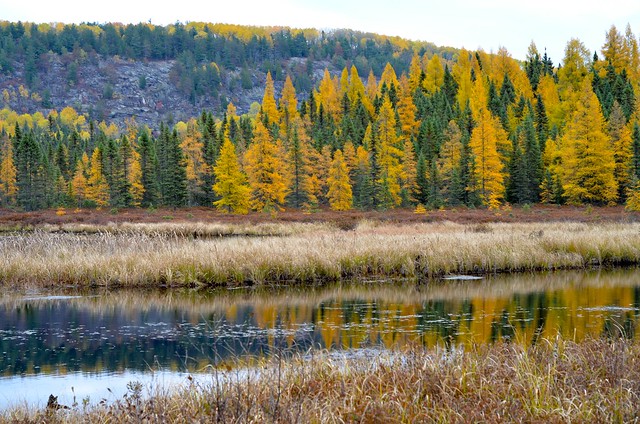
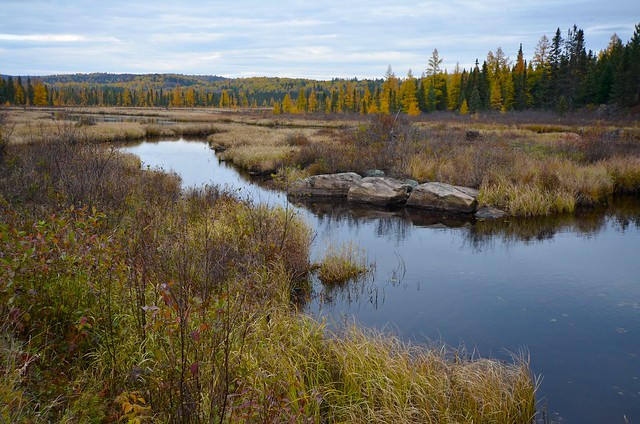
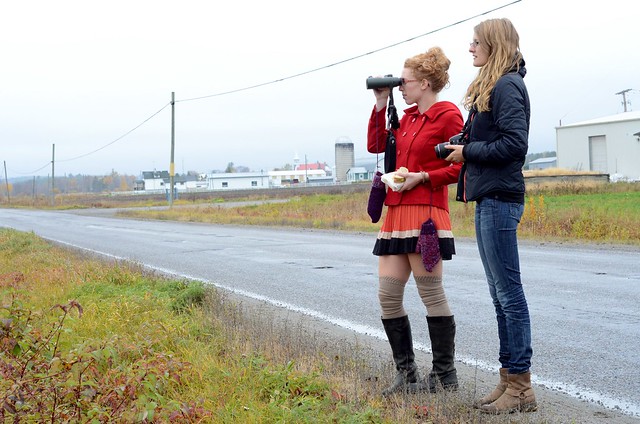

The Northwoods' hardwood trees have almost all lost their leaves but this does not mean there is no color to be seen. The Tamarack, a deciduous conifer, blazes a beautiful golden-yellow, which has replaced the reds and oranges of the hardwoods in Algonquin.


The first destination of my "Northern Adventure" was North Bay - the home of two very close friends of mine whom I've known for years - Sonje Bols and Duncan Hill. They were inviting Sonje's sister Andrea and her cousin Caroline over as well. It was going to be a good weekend.
We went to Science North, where I touched a Beaver (for the first time in who knows how long) and also the Big Nickel
And even managed to get some birding in by stopping to look at some Sandhill Cranes.

How we bird.
The nightlife in North Bay, and this coming from a Torontonian, is quite good. I won't get into much detail as my image is at stake (and some people are concerned about me, apparently), but I will say that we thoroughly enjoyed it. We walked off the after-effects the next morning at Duchesnay Falls (which is beautiful and I recommend it highly), seeing some more birds along the way until it was time for Andrea and Caroline to leave and we said our see-you-laters.
I stayed at Sonje and Duncan's place for one more night, and the next morning Sonje and I birded Laurier Woods for a bit and saw some goodies - A Hoary Redpoll amongst Commons and Pine Siskins, and this -

This adult Northern Shrike was singing it's odd, mockingbird-like song.
Suddenly, I heard a deafening chorus from the fields over the hills. Almost dinosaur-like cackles, trumpets and clatters were produced from birds - Sandhill Cranes about to head into roost. And soon, as wispy lines, they began to appear on the horizon.
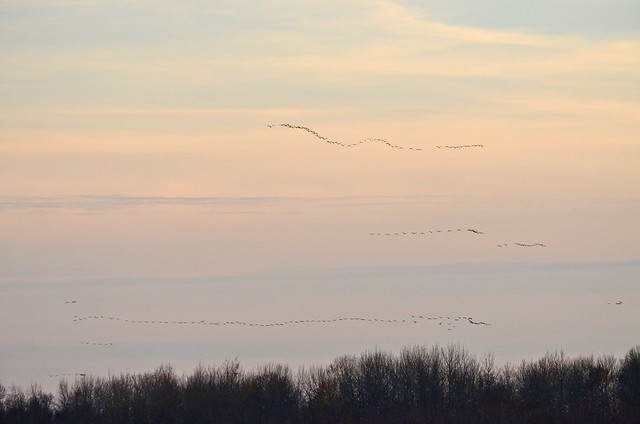
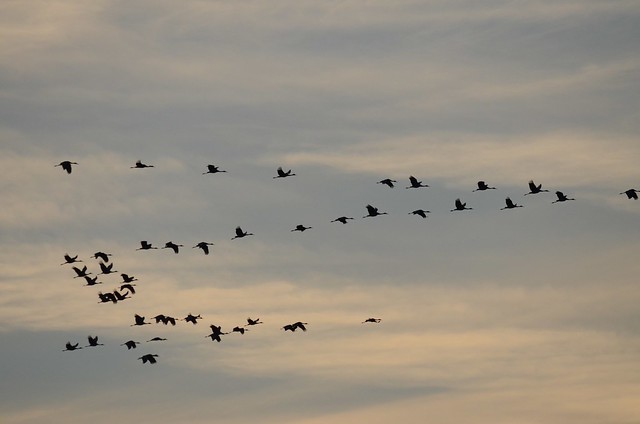
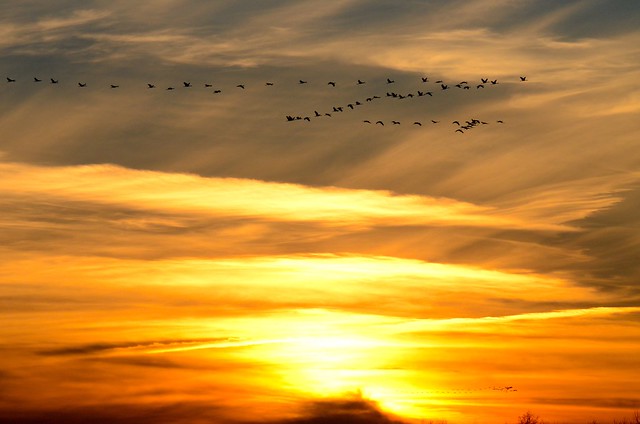
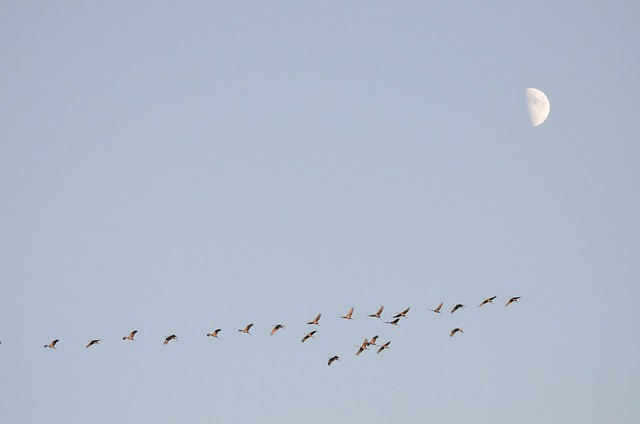
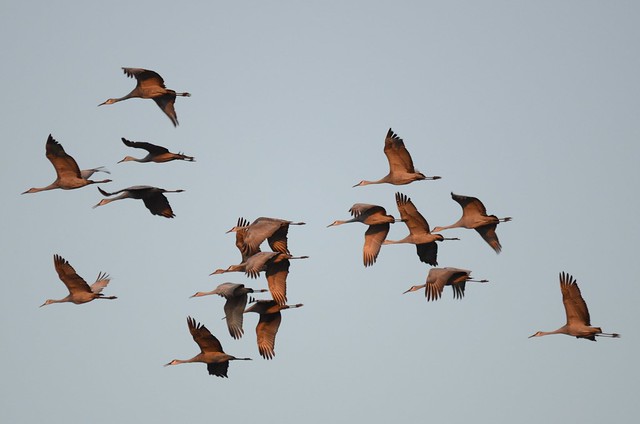
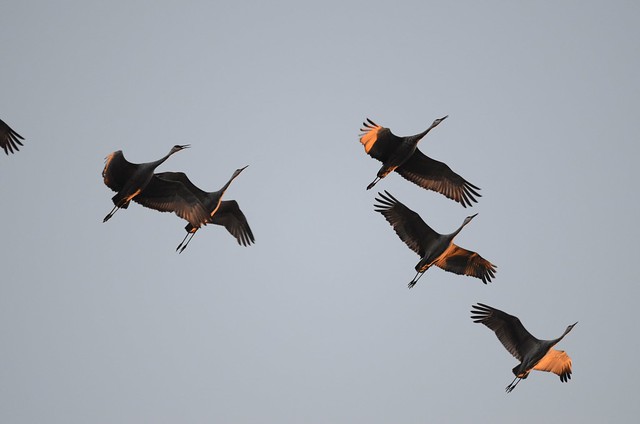
I counted just over 900 birds, and as quickly as they arrived, they were gone. It was almost pitch dark, but to the west the Boreal was backlit by a blood-red sky. And there were night birds stirring.

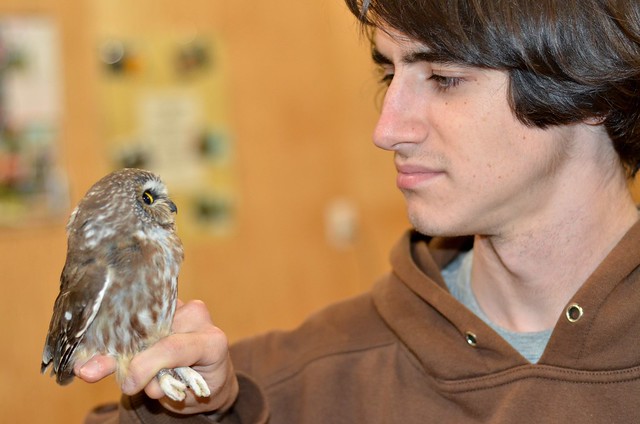
Northern Saw-whet Owl
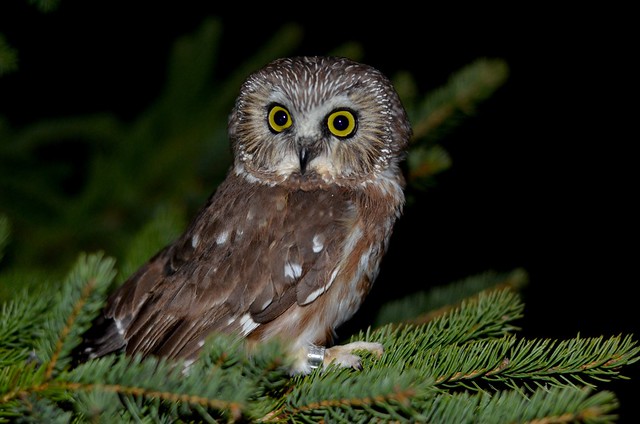
Northern Saw-whet Owl
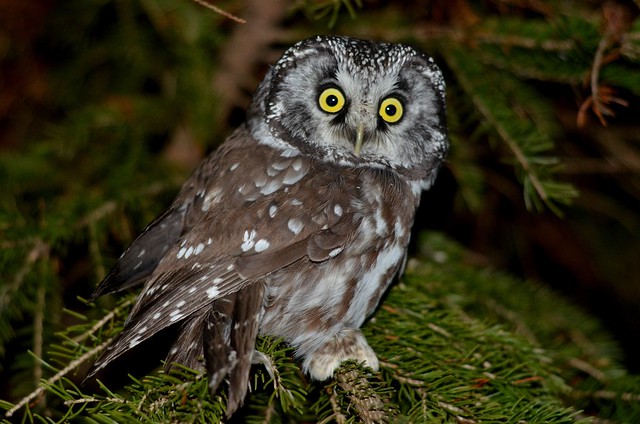
I bid Sonje and Duncan goodbye and thanked them for their hospitality, and headed even further up north for a date with an owl.
I arrived in the true Boreal forest in Northern Ontario well before dusk, so I had some time to kill. It was beautiful up here, where the hardwoods give way to vast forests of spruce, tamarack and pine.
Suddenly, I heard a deafening chorus from the fields over the hills. Almost dinosaur-like cackles, trumpets and clatters were produced from birds - Sandhill Cranes about to head into roost. And soon, as wispy lines, they began to appear on the horizon.

At first there were dozens. In just a few minutes, there were hundreds.



As they came closer, some went right over my head.


I counted just over 900 birds, and as quickly as they arrived, they were gone. It was almost pitch dark, but to the west the Boreal was backlit by a blood-red sky. And there were night birds stirring.

The Boreal Owl, also called Tengmalm's Owl, is weird. Though Tengmalm's is relatively well known from studies done in Scandinavia, it's darker cousins in North America are little-studied and in recent years we are just starting to figure them out. They are strongly migratory in relation to food sources (probably mostly Red-backed Vole), but where they go is unknown. This year is the fourth year in the cycle, and Bruce Murphy has been catching record numbers of them at Hilliardton Marsh, near New Liskeard in Northern Ontario. He is no doubt contributing a lot of information about these little-known owls, especially if his birds are ever recaptured elsewhere. I helped Murph band them for a couple of nights.
They are very painful to take out of the net. Boreals, like most owls, are sexually dimorphic in the fact that the females outweigh the males. The bird I am holding is a large female - the males are scarcely larger than a big Northern Saw-whet, another migratory owl.
Saw-whets are more predictable in their movements, as recapture data shows many of the little owls wintering in the midwest - Pennsylvania, Kentucky, Virginia and the like, where deep snow does not threaten their survival. They, unlike from what we know of the Boreals, move in numbers every year (though some years more than others)
They are very painful to take out of the net. Boreals, like most owls, are sexually dimorphic in the fact that the females outweigh the males. The bird I am holding is a large female - the males are scarcely larger than a big Northern Saw-whet, another migratory owl.
Saw-whets are more predictable in their movements, as recapture data shows many of the little owls wintering in the midwest - Pennsylvania, Kentucky, Virginia and the like, where deep snow does not threaten their survival. They, unlike from what we know of the Boreals, move in numbers every year (though some years more than others)

Northern Saw-whet Owl

Northern Saw-whet Owl
I have only ever been lucky enough to see one Boreal Owl in my life prior to these few days, where we banded more than a dozen of the enigmatic northerners. It is truly one of North America's most difficult birds to see, and it felt wonderful to have the bird in the hand for close inspection.
With that, I ended by Ontario season. Look for a post in the next few days about the highlights.
I drove back to Toronto, and within a few days I was back at Rancho Naturalista, in the Caribbean Foothills of Costa Rica, for another adventure. Life is grand. Within three days, I went from Boreal and Saw-whet Owls to Mottled and Crested Owls, simultaneously singing away on my first night.
I went, very quickly, from one paradise to the other. Sometimes I think to find something more steady than this romantic, Bohemian lifestyle that I've been living. Nobody knows where I'll go...not even me. It somewhat reminds me of some owl....

And then, of course, I remember there are birds and places to be seen and forget about it. I'll make it work - the waxwing does fine and so will I. Anyhow, how else am I to get material for this blog?
Collared Aracari in my yard.
Tuesday, October 16, 2012
The Great East Algonquin Bird Hunt
Algonquin is big. There is no denying it. At 7630 square kilometres, even as a staff member, one will probably never see much of the park unless you go on a really long canoeing trip.
There is one other way to explore Algonquin - if you're lucky enough to have access to the interior logging roads closed to the public, you can drive right through the interior and into some spots that would take days to get to on canoe. And many of these spots offer incredible birding.
Yesterday some of the crew - Katsu Sakuma, Dawn Sherman, Ian Shanahan and myself went into the interior to see what there is to be seen. It still takes several hours to get there, but we knew the rewards could be incredible.
The day started off pretty well, even on the West Side of the Park. As we were heading out in the early morning, the first bird of the day was Great Gray Owl on the road.

Dawn had been trying to catch up with this bird many times, but it never cooperated until today. It's been moving around a lot lately, and has nearly ended up as road jerky a couple of times. Hopefully it'll reach its second year. We watched it for a few minutes and continued towards our quarry.
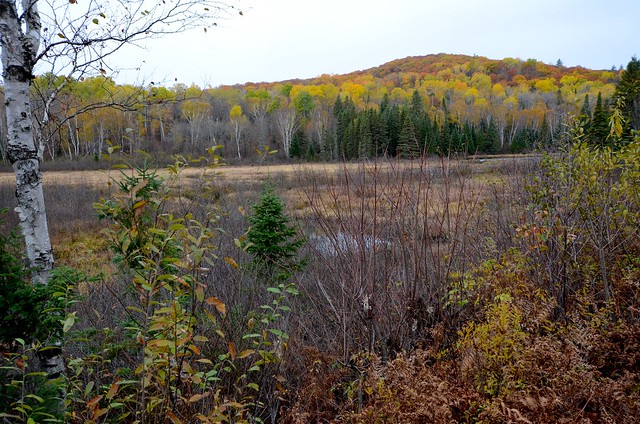
The East Side of Algonquin is a quiet, beautiful place - the interior seeing very few people other than loggers and hunters out for the big bulls at this time of year. Much of the maples are now replaced by poplars, oaks and three species of pine, all three preferring the well-drained, sandier soils of this lower elevation portion of the park. While the colors had all but disappeared from the Western Uplands, the subtle yellows and reds of the aspens and oaks was still very much in evidence on the East Side.
As we were driving along the logging roads, a large weasel crossed in front of our car.
"Holy sh!t - that was a Fisher."
It was going to be a good day.
We reached our first destination - the site of an old mill. It was a huge clearing in the middle of closed forest - any open-country bird migrating through will have to stop here. We had to put on blaze orange hats and vests as we were in moose country and didn't want to be mistaken for them! We were very excited, and even moreso when we noticed a flock of birds we very rarely see on the West Side - Eastern Bluebirds.

Sparrows were everywhere -
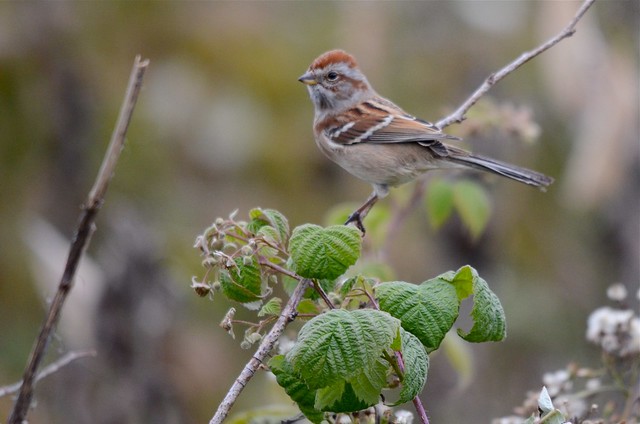
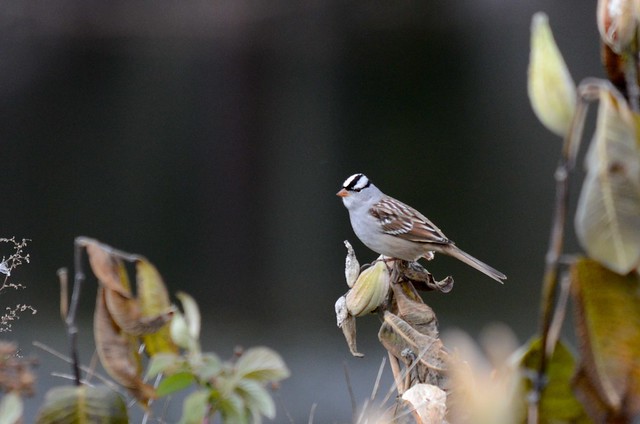

Slate-colored Junco

"Lapland Longspur!"
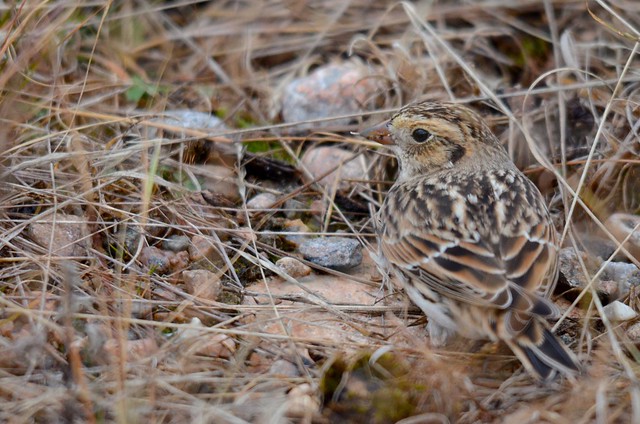
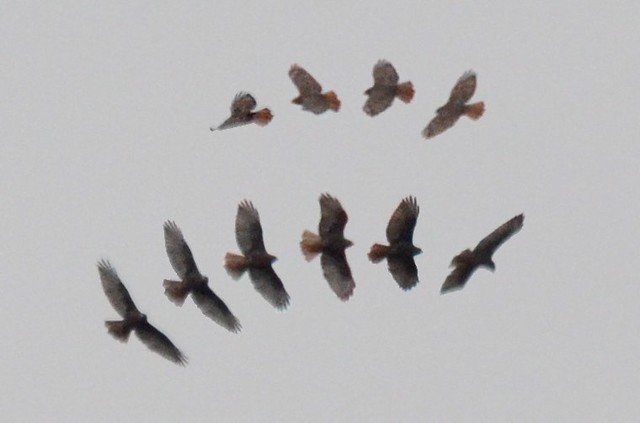
It was a very dark Red-tailed Hawk. I immediately though harlani as Josh saw one earlier in the year in Moosonee (pictures on his blog here) However, it became clear quickly that it wasn't as it had a brick-red tail. This was still very exciting because this is not a common morph we see here - it is much more typical of the Western calurus subspecies and does not knowingly occur with the subspecies we get here most regularly - borealis. There is, however, another subspecies that breeds in the North, with a thick, dark belly band called abieticola. We see these mostly during migration in Southern Ontario, and this subspecies apparently has a rare dark morph, in which case this is most likely it. Jean Iron describes these more detail in the article found here.

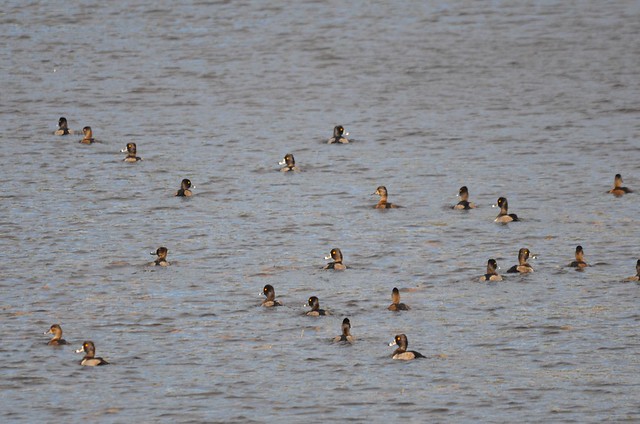
Suddenly, we heard a sound familiar to us from the West Side spruce forests - the nasal call notes of Boreal Chickadee. This was not normal here - the forests here are pine and oak, not regular breeding habitat for this chickadee. The bird was moving very rapidly, calling as it went, until it continued along the lake till we couldn't detect it any further. Likely a migrant. Still, a very good record for the East Side.
The next lake on our journey was one that was reachable by public access, and that is perhaps my favourite lake in the entire park - Lake Travers (pronounced Tra-vair).
The Marsh looked beautiful today. The dark weather made the colors really pop. We went in to see what we could scare out of the cattails and sedges.
A small flock of White-winged Scoters flew by. A pair of Red-necked Grebes were out in the bay. We flushed a Wilson's Snipe. Life was good.
Suddenly, we flushed a sparrow.
The next sparrow we flushed was different. Short-tailed, pale-backed and flew very low, and dropped like a rock into a group of sedges. We all quietly surrounded the place where it landed, and then I saw the bird crawling around a few inches away from my feet. We were looking at Le Conte's Sparrow - a specialty of the Travers Marsh at this time of year.
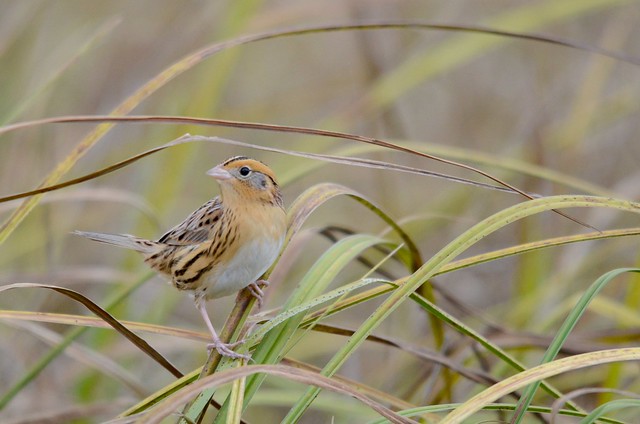
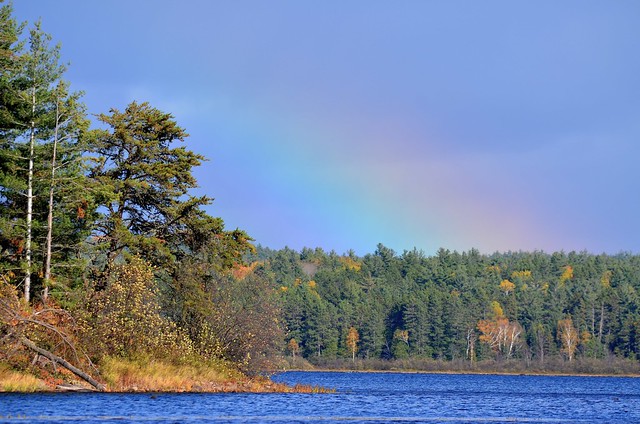
With the Le Conte's in the bag, we were all tired and it was getting dark, so we headed home. We stopped briefly for what was another highlight of the day - Dawn noticed something flying along the road, which proved to be a bat rather than a bird but upon closer inspection, it was a stunning, brick-red male Eastern Red Bat!!
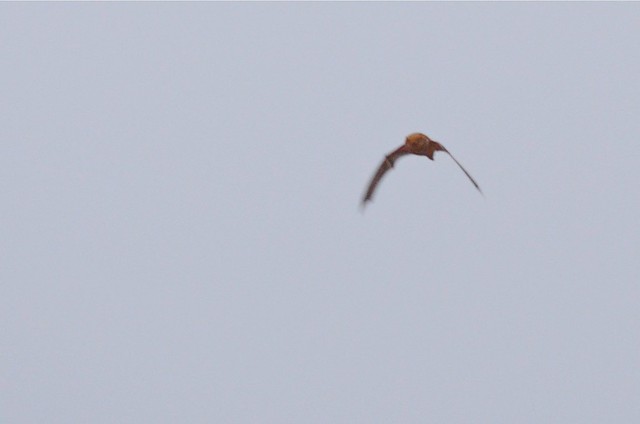
We saw a few more of them as well - likely migrating away from the park to places further south, and we saw another smaller bat that had a gliding flight - perhaps a Silver-haired Bat.
It took us five hours to get back to our side of the Park (remember when I said Algonquin was big?) and the place we were going to eat was closed, but all in all we agreed it was an incredible trip into this very little explored sanctum of Algonquin Park.
There is one other way to explore Algonquin - if you're lucky enough to have access to the interior logging roads closed to the public, you can drive right through the interior and into some spots that would take days to get to on canoe. And many of these spots offer incredible birding.
Yesterday some of the crew - Katsu Sakuma, Dawn Sherman, Ian Shanahan and myself went into the interior to see what there is to be seen. It still takes several hours to get there, but we knew the rewards could be incredible.
The day started off pretty well, even on the West Side of the Park. As we were heading out in the early morning, the first bird of the day was Great Gray Owl on the road.

Dawn had been trying to catch up with this bird many times, but it never cooperated until today. It's been moving around a lot lately, and has nearly ended up as road jerky a couple of times. Hopefully it'll reach its second year. We watched it for a few minutes and continued towards our quarry.

The East Side of Algonquin is a quiet, beautiful place - the interior seeing very few people other than loggers and hunters out for the big bulls at this time of year. Much of the maples are now replaced by poplars, oaks and three species of pine, all three preferring the well-drained, sandier soils of this lower elevation portion of the park. While the colors had all but disappeared from the Western Uplands, the subtle yellows and reds of the aspens and oaks was still very much in evidence on the East Side.
As we were driving along the logging roads, a large weasel crossed in front of our car.
"Holy sh!t - that was a Fisher."
It was going to be a good day.
We reached our first destination - the site of an old mill. It was a huge clearing in the middle of closed forest - any open-country bird migrating through will have to stop here. We had to put on blaze orange hats and vests as we were in moose country and didn't want to be mistaken for them! We were very excited, and even moreso when we noticed a flock of birds we very rarely see on the West Side - Eastern Bluebirds.

Sparrows were everywhere -

American Tree Sparrow

White-crowned Sparrow

Slate-colored Junco
Suddenly, I heard and then saw a different bird land in the long grass, and yelled:

"Lapland Longspur!"
These were lifers for two of us and we got excellent, close looks at them crawling around in the grass like mice. In my effort to photograph a Hoyt's Horned Lark that was with them, I nearly stepped on this one:

I never did get a picture of the pure Hoyt's, a beautiful, pale Horned Lark of the central Arctic, but we all got excellent looks at it - a much bigger bird than the other Horned Larks it was with, with an almost white throat and supercilium. I did however, get a picture of this likely hoyti x alpestris (Northern) Horned Lark integrade.
A fine looking lark, but not quite big enough and showing too much yellow to be a contender for pure Hoyt's. Ron Pittaway talks about Horned Lark subspecies in a great article that can be found here.
Between coursing the long grass like hounds, we looked to the skies every now and again for migrant raptors. We had a young Red-tailed Hawk, and two Sharp-shinned Hawks wing by, and then I saw something different.

(This is a composite shot of the bird - many shots plastered together into one.)
It was a very dark Red-tailed Hawk. I immediately though harlani as Josh saw one earlier in the year in Moosonee (pictures on his blog here) However, it became clear quickly that it wasn't as it had a brick-red tail. This was still very exciting because this is not a common morph we see here - it is much more typical of the Western calurus subspecies and does not knowingly occur with the subspecies we get here most regularly - borealis. There is, however, another subspecies that breeds in the North, with a thick, dark belly band called abieticola. We see these mostly during migration in Southern Ontario, and this subspecies apparently has a rare dark morph, in which case this is most likely it. Jean Iron describes these more detail in the article found here.
After our adventure at this site, our list brimming with all sorts of goodies, we continued on to our next site -

Radiant Lake is located in the depths of Algonquin, but those who have reached it during the right time (a rainy day during migration) have been rewarded with shorebirds and waterfowl galore. For us, the weather was fine enough that we didn't get anything exceedingly rare, but we did get some nice looks at a big raft of Ring-necked Ducks.

Suddenly, we heard a sound familiar to us from the West Side spruce forests - the nasal call notes of Boreal Chickadee. This was not normal here - the forests here are pine and oak, not regular breeding habitat for this chickadee. The bird was moving very rapidly, calling as it went, until it continued along the lake till we couldn't detect it any further. Likely a migrant. Still, a very good record for the East Side.
The next lake on our journey was one that was reachable by public access, and that is perhaps my favourite lake in the entire park - Lake Travers (pronounced Tra-vair).
In particular, we were interested in the Travers Marsh, which was a massive cattail marsh one has to do a bit of bushwhacking to get to, but like Radiant, usually held some goodies.
The Marsh looked beautiful today. The dark weather made the colors really pop. We went in to see what we could scare out of the cattails and sedges.
A small flock of White-winged Scoters flew by. A pair of Red-necked Grebes were out in the bay. We flushed a Wilson's Snipe. Life was good.
Suddenly, we flushed a sparrow.
"Swamp"
And then another.
"Swamp"
and another.
"Swamp"
The next sparrow we flushed was different. Short-tailed, pale-backed and flew very low, and dropped like a rock into a group of sedges. We all quietly surrounded the place where it landed, and then I saw the bird crawling around a few inches away from my feet. We were looking at Le Conte's Sparrow - a specialty of the Travers Marsh at this time of year.
We flushed it a few more times until everyone had a good look, and the bird at one point emerged from the reeds in full view -

The definition of subtle beauty. What an awesome bird. There was no hesitation to crown this lovely little sparrow as the bird of the day, though the longspurs were also contenders.
Everyone was a happy (if not sopping wet) birder.

With the Le Conte's in the bag, we were all tired and it was getting dark, so we headed home. We stopped briefly for what was another highlight of the day - Dawn noticed something flying along the road, which proved to be a bat rather than a bird but upon closer inspection, it was a stunning, brick-red male Eastern Red Bat!!

We saw a few more of them as well - likely migrating away from the park to places further south, and we saw another smaller bat that had a gliding flight - perhaps a Silver-haired Bat.
It took us five hours to get back to our side of the Park (remember when I said Algonquin was big?) and the place we were going to eat was closed, but all in all we agreed it was an incredible trip into this very little explored sanctum of Algonquin Park.
Sunday, October 14, 2012
Fall Advances and Some New Gear!
The Aurora borealis is not common in Algonquin, but when it does occur, it usually does so during mid-late autumn days. Much of the leaves have come off the trees now in the Park, but the Oaks and Aspens are still holding on, and the Tamaracks just getting into the peak of their brilliant golden color.
About a week ago I went out with some friends to find one of the Great Gray Owls that have been present in the Park.
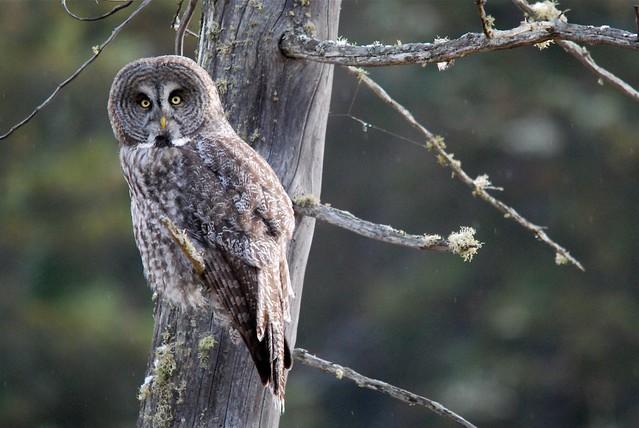
Snow was falling thick from the sky, but the bird didn't seem to mind (it'll have to get used to it anyhow) and we watched it for a couple hours. Larissa and I went to see the bird later that day as well and it was very actively flying around hunting.
When many owls actively hunt they assume an odd, wing-drooping posture:
At one point it cruised by us just at eye level, allowing us a good look at the shape of the bird in flight - a gray, airborne loaf of bread.
This weekend, however, we changed it up a little bit and Larissa and I headed South to Toronto to spend some time with both of our parents and to ultimately spend lots of money at the Henry's Digital Imaging and Video Expo.
I was after a used Nikon D7000, which was a bit of a step-up from the D90 that I shoot with, for a variety of different reasons, but one of the things that I most liked about this over my D90 is that it shoots Full HD video. I have a Youtube Channel (http://www.youtube.com/user/OntBirder) and it's about to get that much more interesting.
The thing was a bargain. Larissa just recently got into DSLR with a Canon Rebel T3i so she bought a whole bunch of gear as well. We had all the fun associated with spending a lot of money. It was great!
The other day I was out with my new setup after cold front to look for anything new, and sure enough, the Park was full of new birds. Fox and American Tree Sparrows have arrived. Some Rusty Blackbirds were hanging around. I was surprised to find a Red-necked Grebe at Lake of Two Rivers. Pipits have become scarce and are now replaced by Horned Larks in the open country, and these allowed me to try out my new gear.
I only have five remaining days here. After that, I will go further up North. I hope to catch Boreal Owl (literally..) and some of our other "winter" birds - perhaps a Shrike, some Pine Grosbeaks, or a Rough-legged Hawk, before I make my journey South to join our warblers and flycatchers that are already down there. As much as I definitely need a change of scenery, there will be birds and people in this lovely country that I will dearly miss. You guys and girls in Ontario will have to keep me posted about the goings-on there, and I will try my best from the hustle and bustle of what will surely be a busy guiding season in the South.
One thing that I won't miss however, is that fluffy cold stuff that y'all seem to love so much...
Subscribe to:
Posts (Atom)


